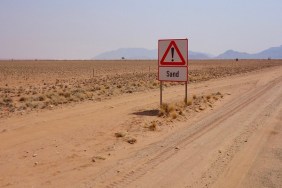The aliens have landed, time and time again since the world began. Not the “little green men” of science fiction, but rocky leftovers from the birth of the solar system: meteors and asteroids. While most of the craters that serve as records of their impacts have been eroded away over the vast expanse of geological time, many so-called astroblemes remain. Here are 10 of the most noteworthy.
Meteor Crater, Arizona, USA
(images via: Travel and Tweet, Absolute Astronomy and The Living Moon)
Located about 40 miles east of Flagstaff, the 4,000 ft wide and almost 600 ft deep Meteor Crater owes its startlingly lunar aspect to both a relatively young age (about 40,000 years) and the arid climate of the northern Arizona desert in which it is situated. It’s estimated that the mainly nickel-iron Canyon Diablo Meteorite was about about 55 yards (50 meters) in diameter and weighed approximately 150,000 tons.
(image via: Advanced Physics Forum)
Meteor Crater is, perhaps surprisingly, privately owned and has remained the property of the Barringer family since 1903. Tourists are charged a $15 entrance fee by Meteor Crater Enterprises and a visitor’s center on the crater rim offers multimedia presentations and a chance to handle meteoric iron fragments found in the area.
Here’s a video of a trip via air to Meteor Crater. Flying INTO the crater is not recommended – in 1964 a small Cessna airplane flew into the crater and found itself unable to exit due to persistent downdrafts – it eventually crashed on the crater floor.
Wolfe Creek Crater, Australia
(images via: Chris Images and Fossicking)
Like Meteor Crater in Arizona, Wolfe Creek crater owes its well-preserved state to both age (around 300,000 years) and the environment of the Australian Outback. Approaching the crater on land, visitors must first climb over the 80 ft (25 meter) high rim before descending to the sand-covered crater floor 165 ft (50 meters) below the rim.
(image via: Prism Reptile Robot)
Both oxidized iron meteorite fragments and pieces of impact glass (formed when sand is melted) have been found in the area of the half-mile wide Wolf Creek crater, attesting to its astronomical origins. As well, the center of the crater is dotted with outcroppings of gypsum, a white mineral that holds water and allows for the growth of trees and shrubs in the otherwise inhospitable desert.
Manicouagan Crater, Quebec, Canada
(images via: CBC, Syrtis and Flatrock)
Manicouagan crater is one of the oldest visible impacr crater, due likely to its location on the tough Canadian Shield about 190 miles north of the city of Baie Comeau. The lake that surrounds the central raised plateau of the crater is about 40 miles in diameter.
(image via: Roche-Noire)
An interesting theory put forth by David Rowley, John Spray and Simon Kelley posits that the Manicouagan crater, the Rochechouart crater (France, above), the Saint Martin crater (Manitoba, Canada), Obolon’ crater (Ukraine) and Red Wing crater (North Dakota, USA) were created in a single “crater chain” caused by a large asteroid that broke up high in the Earth’s atmosphere. Though continental drift has shifted the craters around the globe, 214 million years ago they were closer together and roughly aligned – so much so that they may have been the cause of an extinction event in the late Triassic Period of the Mesozoic Era.
(image via: The Blog Of Record)
The amazing image above, taken from the International Space Station orbiting high above the Earth, shows a unique view of the Northern Lights with Manicouagan crater in the foreground.
Wetumpka Crater, Alabama, USA
(images via: UNB and Auburn Astro)
Approximately 82 million years ago, an 1,100 ft wide meteorite impacted the shallow sea north of what is now the city of Montgomery, Alabama. What remains today is one of the best preserved marine craters on Earth. Measuring approximately 5 miles wide, the Wetumpka crater features rocky outcrops on the exposed crater rim and central uplift that clearly show the effects of a sudden impact on marine bedrock.
(image via: Falling Rocks)
The above artist’s conception by Jerry Armstrong shows what the Wetumpka crater may have looked like a short (in geological terms) time after the impact.
Lonar Crater Lake, India
(images via: KarthikCK and UNB)
One of India’s most famous meteorite impact craters is the Lonar crater lake, located near the town of Sultanpur in India’s Maharashtra state. Measuring just over a mile wide from rim to rim, the crater is partially filled by a salty, alkaline lake 3,900 feet (1,200 meters) in diameter. The Lonar crater was created by the impact of a comet or meteor in the Pleistocene epoch roughly 52,000 years ago.
(image via: UNB)
Lonar crater retains much of its original shape and appearance, due in part to the lack of glaciation in that area of India and also the hardness of the volcanic basalts which make up much of the region’s bedrock.
Pingualuit Crater, Quebec, Canada
(images via: UNB, Artnet/Stan Gaz, YJT-Korea and Nunavik Parks)
Discovered in the mid-1940’s but known to indigenous native people as the “Crystal Eye of Nunavik”, Pingualuit crater is the site of a meteor impact that occurred approximately 1.4 million years ago. The lake that today fills the crater is fed only by rain and snow, resulting in exceptional water purity with a salt content of just 3 ppm (the Great Lakes average 500 ppm).
(image via: U Laval)
Formerly known as the New Quebec Crater, Pingualuit crater is located in Quebec’s far northern Ungava peninsula and measures 2.14 miles (3.44 km) in diameter.
Kaali Crater, Estonia
(images via: Muinas-Kaali, CJSveningsson and Carlosj)
Around 660 BCE, a meteor entered the earth’s atmosphere, broke up into at least 9 pieces, and impacted the Baltic island of Saaremaa with the force of a Hiroshima-type atomic bomb. Some of the craters later filled with groundwater but retain their characteristic circular shape as they were formed long after Ice Age glaciers retreated. The largest Kaali crater is about 300 ft (100 meters) in diameter and is filled with groundwater, the level of which varies with the seasons.
The Kaali event may have impacted more than just the land; hints of what must have been a terrible human tragedy can be found in ancient Viking and Finnic epic poems as well as in Norse mythology. The main Kaali crater has been called “Holy Lake” and it may have been used in pagan rituals.
Gosses Bluff Crater, Australia
(images via: UNB, TIME, TrekNature and Gabriel)
Gosses Bluff crater looks pretty good for its age: about 142 million years! Located in Australia’s Northern Territory, the ruggedly beautiful crater features a central ring of peaks that soar 500 ft (150 m) into the crystal clear Outback skies. A popular tourist destination (but perhaps not for the cruise & cabana set), Gosses Bluff crater can be found about 110 miles west of the town of Alice Springs.
(image via: All-Experts)
The arrival of the Gosses Bluff bolide was the ultimate “Jurassic park”, causing widespread devastation and leaving an impact crater 13.5 miles (22 km) in diameter. Time has left its mark, local climate conditions notwithstanding, and currently the Gosses Bluff crater is “only” 3 miles (5 km) wide.
Clearwater Lakes, Quebec, Canada
(images via: UNB and Wikimedia)
The Clearwater Lakes are a pair of water-filled impact craters located in Quebec, Canada, near the shore of Hudson Bay. Like other craters of extreme age – in this case roughly 290 million years – the twin craters have retained their basic structure due to the rigid bedrock of the Canadian Shield.
(image via: UNB)
The circular lakes are 26 km and 36 km in diameter, and one lake features an inner circle of islands that attest to its original multi-ringed form. The phenomenon of double craters, while rare on the Earth, is often seen on other rocky planets and moons elsewhere in the solar system. he cause may be that the original impactor broke in two during its plunge through the atmosphere or, as some have postulated, that the asteroid was accompanied on its final journey by a moon.
Wilkes Land Crater, Antarctica
(images via: Physorg and Shackleton Centenary)
With the advent of accurate satellite mapping and powerful cameras that record beyond the limits of human vision, new craters and/or remnants thereof are continually being discovered. Being a global phenomenon, even icebound Antarctica is not immune: what may be the largest crater ever recorded may have been found, locked beneath the massive ice sheet for many millions of years. If current theories on the anomaly are proven, they indicate a 300 mile (483 km) wide crater smashed into the Antarctic coastline about 250 million years ago. Antarctica was warmer back then; especially so on the grim day a 30-mile wide asteroid arrived with a very big bang.
(images via: LANL and LPI-USRA)
The Wilkes Land crater, possibly formed in conjunction with the 125 mile (200 km) wide Bedout crater in nearby Australia, may have been caused by bolides whose after-effects led to the worst mass extinction in Earth’s history: the Great Dying which closed the Permian period. Could it happen again? We can only hope not… so wish upon a star!







